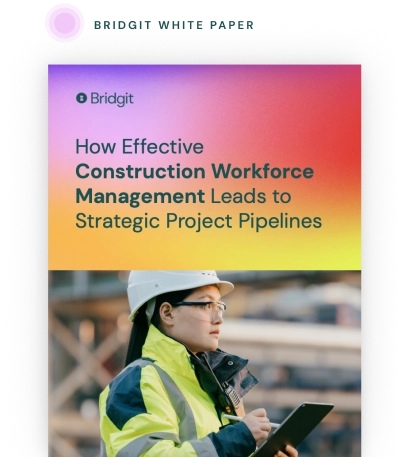The culture around construction employment has dramatically changed in recent years. As baby boomers begin to retire and millennials now make up 35% of the workforce, many general contractors wonder how to make their organization more attractive to younger workers who don’t see construction as a fulfilling career choice.
Table of Contents
A skills gap in the construction industry isn’t necessarily a bad thing. A relatively small gap in the demand and supply is a good indicator of a growing industry and allows workers to change jobs to further their careers. On the other hand, too many job openings compared to the available workers lead to difficulty filling positions, and the pipeline for workers is falling behind the demand.
Using your data to identify skills gaps
A survey by the Associated General Contractors of America (AGC) found that 80% of contractors are having difficulty finding skilled workers. This difficulty is amplified by the urgency of replacing an aging workforce moving toward retirement.
In this article, we will explore ways you can use your data to help reduce your skills gap.

Use your workforce data to create a competitive advantage
Download our white paper to see how effective workforce planning can help stay ahead of labor demands and create a strategic project pipeline.
Understand your skill gaps
No one can understand the specific skills you need to close your skill gaps better than you can. If you need skilled workers, it’s important to highlight the specific skills and experience you’re looking for. If you’re using a construction workforce management tool that allows you to track experience and skills, take the time to analyze your team’s data to understand exactly what your existing expectations are for specific roles in your organization.
A report by Burning Glass Technologies, a labor market analytics provider, indicates that the construction industry has had more supply than demand for skilled workers over the past few years. That supply-to-demand ratio, however, has diminished year after year. Part of the problem is that organizations often demand skill sets and experience instead of training and experiential learning. Everyone wants to hire the “best of the best”, but often, candidates who qualify for positions will be overlooked because the demands exceed that of the existing qualifications of the current team.
Ryan Companies takes on this problem by creating a development plan to help current employees learn from various angles. Erin O’Hara Meyer, the Senior Director of Talent Development at Ryan Companies, explains:
“We ask people to think about their goals and objectives, what they need to know, what they need to learn, and let them begin by taking responsibility for what’s most important to them.
Beyond that, learning comes from various sources, especially today. There’s on-demand learning, videos, virtual sessions, in-room sessions, coaching, and peer interaction. They’re learning every day, whether they recognize it or not. But the amount of time we can invest gets tighter as we get busier. We’re in the same boat as all those other GCs. Time is really of the essence and is a valuable commodity. So we aim to focus on what’s most important and offer it in digestible time.”
We live in an experience-based economy, and that mindset carries over to how and where we choose to work. General contractors that invest in providing employee skills development and experience rather than demanding it are more likely to retain high-performance individuals in the long run.
Create a path to career success
This will start with company culture. Your organization should emphasize engaging employees with opportunities for new training, experiential learning, and mentorship programs. It should also clearly define employees’ roles, responsibilities, and qualifications as they work their way up through the company.
So, how can you incorporate training and experiential learning while understanding the importance of completing projects on time? Ryan Companies tries to achieve this balance through its Emerging Leaders program. O’Hara Meyer told Bridgit the program is based on three pillars of learning:
“The first pillar is professional development. We offer everything from management skills to leadership training and personal and professional development. The second pillar is understanding business operations. We invite many leaders throughout the year for questions and answers on what leadership means to them, things they’ve learned along the way, and strategies for reaching our goals and objectives.
Then, the year culminates in a project. Early on, they’re given a project that they have to research, solve, and recommend. These projects are deemed important, and at the end of the year, they present as teams to our leadership to say that we recommend this or we don’t recommend this, and here’s why.
Where does data come into play? Tracking experience with insight into project history will allow you to stay ahead of opportunities for career advancement. It’s great to have employees interested and ask about new company opportunities. Still, it’s equally great for your company culture if those opportunities are offered from the top down.
By addressing your team’s experience and emphasizing growth and development, employees will be more likely to engage in their organizational culture. This will help to change the perception of working in the construction industry and, more specifically, your company.
Understand your hiring trends
This can be one of the most difficult trends to predict, given the dynamic nature of construction projects and the industry as a whole. Too often, the recruitment process is reactionary to immediate project needs. Construction workforce management tools that offer insight into your workforce utilization will help forecast future staffing needs.
Companies like Wohlsen Construction are using these tools to make strategic business decisions about what projects they go after to ensure they have the right talent in place for a pursuit before it is awarded. Ed McCauley, the Vice President of Innovation at Wohlsen, explains how Bridgit Bench helps them do this: “In Bridgit Bench, what-if scenarios are easy to implement. We can see the impact, learn on the fly, and make quicker decisions. I think that the speed-to-decision that Bench gives us has helped in planning and determining go/no-go scenarios. We can ensure that we have the talent to put on the project to be successful for ourselves and also for the clients.”
You should aim to identify areas in the coming months or even years where your team is spread too thin. Identifying these areas early will give you ample time to begin the recruitment process for your required roles. It also provides you with enough time to train candidates or current team members to take on required roles.
Your insight into workforce utilization will also help identify when your company can take on more work. These gaps can often lead to periodic layoffs for team members, leading to employees understandably seeking work elsewhere. However, these gaps in productivity are also opportunities to provide new training and mentorships to high-performing individuals to keep them engaged with your organization through downtimes.
Think your workforce planning meetings could be more productive?
Download our ebook to learn how to run efficient, effective workforce planning meetings with your team.



